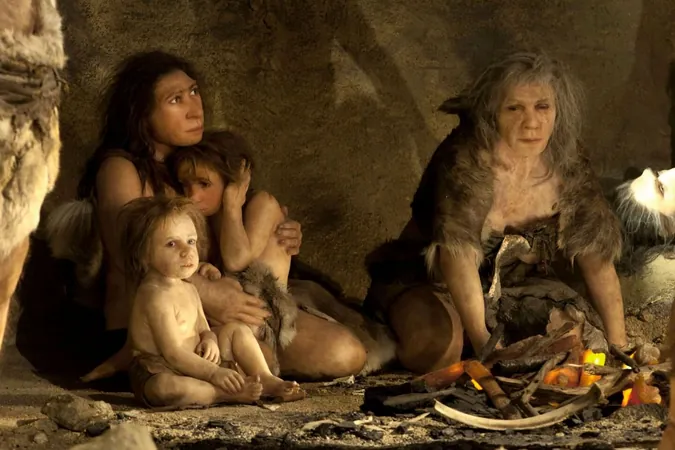
Discover the Culinary Secrets of Neanderthals: Maggot-Infested Meat as a Delicacy?
2025-07-28
Author: Yu
The Surprising Culinary Culture of Neanderthals
Picture this: a group of Neanderthals gathered around a flame in a frigid cave, sharing a meal in a scene that could have unfolded over 300,000 years ago. In the heart of Europe, they await their hard-earned lunch—a piece of gazelle, cooked to perfection without pots or spoons, employing savvy cutting techniques using sharpened flint.
But here’s the kicker: their menu may have included a controversial delicacy—rotting meat swarming with maggots. While today this might seem repulsive and dangerous to most, for Neanderthals, it might have been a strategic nutritional choice.
New Studies Uncover Neanderthal Diet Secrets
Recent research, published in the journal *Science Advances*, shines a light on this fascinating culinary practice. It suggests that the elevated nitrogen levels found in Neanderthal bones could be attributed to their consumption of larvae—those pesky little critters thriving on decaying meat. While previous interpretations labeled them as hypercarnivores at the top of the food chain, this assumption has raised eyebrows. As humans, we can't digest protein levels on par with specialized carnivores.
Ainara Sistiaga, a researcher at the University of Copenhagen, emphasizes the importance of considering unconventional food sources like maggots. Today, such practices are rare, with few cultures, like the Inuit, indulging in fermented meats.
What the Research Reveals
The findings suggest that Neanderthals made a calculated choice to feast on maggot-infested meat, significantly boosting their protein intake during harsh winters. The larvae’s higher nitrogen levels influenced their isotopic signatures, complicating our understanding of Neanderthal nutrition.
However, skepticism lingers. Manuel Domínguez-Rodrigo from the University of Alcalá warns that this theory remains speculative. There's still much uncertainty about what fueled the high nitrogen levels in their bones—perhaps even manure could lead to similar isotopic signatures.
Cultural Diversity in Food Practices
Another recent study published in *Frontiers in Environmental Archaeology* highlights how two Neanderthal clans from neighboring caves in the Levant exhibited distinct animal butchering methods. Anaëlle Jallon from Hebrew University asserts that these differences indicate a rich cultural diversity surrounding food among contemporaneous Neanderthal groups.
Despite sharing the same environmental resources, the two communities developed unique food processing techniques that persisted across generations. This suggests they may have had their own ‘signature dishes’—a rich tapestry of culinary practices tailored to their tastes and skills.
Reconstructing the Neanderthal Diet: A Complex Puzzle
Rebuilding a comprehensive picture of the Neanderthal diet proves as challenging as defining modern human cuisines. With their expansive territory, a one-size-fits-all food atlas is unrealistic. Some of their food choices, like meat, left archaeological traces, while others, like fruits and vegetables, often did not survive the ages.
Efforts like dental tartar analysis offer glimpses into their plant-based diets, but findings remain sporadic. Neanderthals indeed consumed more than just meat; evidence suggests they enjoyed charred seafood, gathered mushrooms, and possibly even harvested honey.
The Evolutionary Impact of Diet
What’s indisputable is that the search for nutritious food played a pivotal role in human evolution. Some studies indicate that the roots of cooking date back over six million years, ultimately influencing our modern brain's size and function. The quest for flavor optimization may have propelled our ancestors forward, even if it started with an unappetizing feast of maggot-infested meat.



 Brasil (PT)
Brasil (PT)
 Canada (EN)
Canada (EN)
 Chile (ES)
Chile (ES)
 Česko (CS)
Česko (CS)
 대한민국 (KO)
대한민국 (KO)
 España (ES)
España (ES)
 France (FR)
France (FR)
 Hong Kong (EN)
Hong Kong (EN)
 Italia (IT)
Italia (IT)
 日本 (JA)
日本 (JA)
 Magyarország (HU)
Magyarország (HU)
 Norge (NO)
Norge (NO)
 Polska (PL)
Polska (PL)
 Schweiz (DE)
Schweiz (DE)
 Singapore (EN)
Singapore (EN)
 Sverige (SV)
Sverige (SV)
 Suomi (FI)
Suomi (FI)
 Türkiye (TR)
Türkiye (TR)
 الإمارات العربية المتحدة (AR)
الإمارات العربية المتحدة (AR)